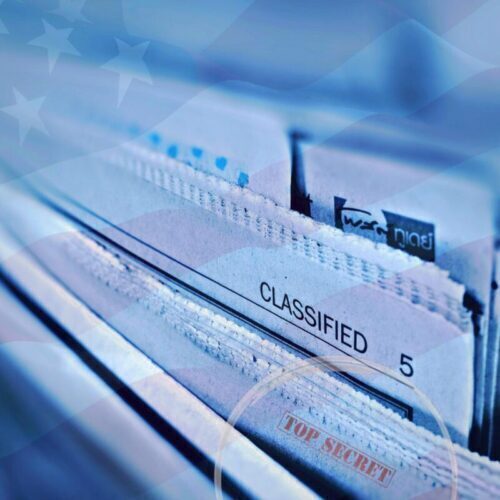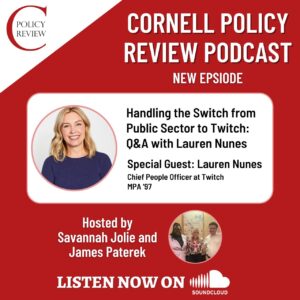
Graphic by: Sarah Lu
Written by: Domenic Boresta, Politics & Public & Nonprofit Management
Edited by: Grant Ewing, Politics & Public & Nonprofit Management
_____________________________________________________________________________
I. Sanctity of National Security Information
In November 2020, then-President Donald J. Trump lost re-election to Joseph R. Biden. After leaving the Oval Office in January 2021, Mr. Trump moved into his residence in Florida, Mar-a-Lago. Between January and May 2021, The National Archives and Records Administration (N.A.R.A.) was privately informed that boxes of records were found at Mar-a-Lago and made a formal request for their return. The N.A.R.A. made several subsequent attempts to recoup these presidential records, ultimately asking the U.S. Department of Justice (D.O.J.) to issue a search warrant to recoup these records; nothing happened. On August 8, 2022, the Federal Bureau of Investigation (F.B.I.) took unprecedented action, executing a search of the former president’s home and seizing all documents with top secret clearance or higher. During the search, investigators found classified documents in three unsecure locations: the basement at Mar-a-Lago, in a container within Mr. Trump’s home office closet, and in a former suite dressing room.1
The United States’ (U.S.) trove of top-secret intelligence is among the country’s most protected information. If this information falls into the wrong hands, it threatens national security and compromises the safety of the many spies and foreign citizens involved in gathering, protecting, and disseminating information. These consequences can be life-or-death, and the stakes are particularly high for foreign citizens who serve as U.S. government informants. Informants are citizens of foreign nations that provide privileged information to the U.S. They are so important to national intelligence that their identities are among the most protected information the country holds. Keeping informants’ demographic information secret is paramount to progressing U.S. intelligence, and failures to do so have dire consequences. For instance, during the last decade, it was uncovered that Chinese authorities had successfully infiltrated the U.S. intelligence community. From 2010 to around 2013, the Chinese Communist Party systematically dismantled the Central Intelligence Agency’s (C.I.A.) network of agents across the country, executing dozens of suspected U.S. spies and crippling the U.S. intelligence network in China.2 This setback hurt U.S. intelligence as they lost many covert assets.
Not only can breaches hurt U.S. officers, but they can hurt their national connections too. After the 2011 killing of Osama Bin Laden, government officials from Pakistan discovered five informants, who provided the U.S. with details on Bin Laden’s whereabouts. These informants were arrested and imprisoned.3 Julian Barnes, a national security reporter for The New York Times, details the consequences of a compromised informant: “Losing [an informant] can [mean] (sic) an informant is arrested, and no longer can talk to the United States because the source is now in a prison overseas. It also can mean that the source is executed, as many countries will promptly kill somebody suspected of being a spy for the United States.”4 Thus, losing an informant can have dire consequences for the U.S. intelligence community. Citizens can only hope that any compromises are due to the workings of foreign governments, not of a U.S. failure to keep informant information secret.
II. The Importance of What Was Recovered at Mar-a-Lago
In October 2021, almost a year prior to the Mar-a-Lago search, The New York Times reported that the C.I.A. had disclosed, within a top-secret C.I.A. cable, that an unusually high number of foreign citizens serving as U.S. government informants had been killed, arrested, or compromised by rival intelligence agencies. The C.I.A. admitted it had no concrete evidence as to why this was happening, and could only point to internal measures like “poor tradecraft; being too trusting of sources; underestimating foreign intelligence agencies and moving too quickly to recruit informants.”5 There may be more information about why this was occurring, and the F.B.I. document seizure at Mar-a-Lago in August 2022 suggests a possible explanation.
The New York Times reported that the D.O.J. search of Mar-a-Lago was instigated by the discovery of highly classified material related to “clandestine human sources.”6 This was confirmed by the F.B.I. affidavit from Mar-a-Lago, alluding that the documents contained information on the C.I.A.’s Human Intelligence Control System (HCS), a system designed to protect intelligence information derived from clandestine human sources. The HCS intelligence documents contain details about the sources of the information–informants themselves. In some cases these details are general, such as if an unidentified clandestine source has direct or secondary intelligence knowledge. In others, these details are more descriptive and could provide identifiable information. The New York Times states the documents retrieved from Mar-a-Lago in January 2021 included some files demarcated as HCS information which could possibly identify C.I.A. informants.7 Protection of these informants’ information is why the C.I.A. and the intelligence community may have originally sought control over the HCS intelligence documents as soon as Donald Trump left office, then had the N.A.R.A. refer the DOJ to recoup this top-secret, national information.8
III. A Plausible Explanation
Though it is uncertain if foreign intelligence ever accessed these documents, media reports indicate one possible occurrence in Inna Yashchyshyn. In May 2021, Yashchyshyn successfully posed as a member of the Rothschild family to gain access to Mar-a-Lago. At that time, the F.B.I. reported that Yashchyshyn hoped to make Trump family connections and raise money. Little is known about Inna Yashchyshyn other than that she is a Russian-speaking Ukrainian immigrant who used a fake identity to gain access to and build relationships with several U.S. politicians, including Donald Trump. Her link to any foreign government agency is unknown; however, two truths remain: (1) she is closely linked to a Moscow-raised businessman named Valeriy Tarasenko (who provided the F.B.I. with her motivations and actual identity during a deposition), and (2) she used a fake alias to gain special access into Mar-a-Lago.9
Donald Trump eventually returned fifteen boxes of documents in January 2022 in accordance with the Presidential Records Act. All but one of these boxes have top-secret classification markings or higher, and some of the documents were missing.
The N.A.R.A. received a covert tip that there were still more documents at Mar-a-Lago and then made a referral to the D.O.J. This tip suggests that former President Trump knowingly sent back some (but not all) of the documents to the D.O.J., and that someone else had knowledge of Mr. Trump’s decision and alerted the U.S. government. Even after the F.B.I. search, more top-secret files may remain. Of the documents recovered by the N.A.R.A, some folders were empty, leading the D.O.J. to believe more top-secret records are still at Mar-a-Lago.10.11
IV. What to Look For
There is one way the U.S. government would know who had access to documents: the Mar-a-Lago security tapes could link the evidence between who had access to what information, and if that information confirms any missing foreign informants. A lawyer and advisor at the National Security Agency, Glenn Gerstell, stated the intelligence community has “surveillance tapes and we will see who had access.”12 In September 2022, a federal judge released an unredacted affidavit of the Mar-a-Lago search, confirming the Trump Organization’s counsel complied in turning over Mar-a-Lago security camera footage to the D.O.J.13 If the D.O.J. can provide visual evidence to the public of a known foreign spy at Mar-a-Lago obtaining top-secret files, that would truly be damning. If those top-secret files were related to HCS information on compromised C.I.A. informants, the implications would be dire.
The F.B.I. search of Mar-a-Lago gave the American public much more knowledge than it previously had. The public already knew that foreign informants working for the U.S. government had been going missing at a higher-than-normal rate. Following the search, the public now knows that the documents recovered from Mar-a-Lago contained information pertinent to human intelligence. Due to the overlapping timelines, there is a likely possibility that these stories are related. It is also possible that these findings may also all be purely coincidence, and that former president Donald Trump neither intended to keep the documents nor were they viewed by any foreign threats. However, these certain events fall under a timeline and create cause for investigation. Whether there is a cross-reference to confirm the link may not be known for a long time, and whether Inna Yashchyshyn’s Mar-a-Lago visits prove a link may also not be known. Perhaps the public may never know the answers to these questions. However, specific wording in the future indictment of Donald J. Trump will be critical in understanding information investigators have confirmed and information officials are still seeking.
Notes
- Thrush, Glenn, Alan Feuer, and Maggie Haberman. “Documents at Mar-a-Lago Could Compromise Human Intelligence Sources, Affidavit Says,” New York Times (New York, NY), Aug. 26, 2022.
- Mazzetti, Mark, Adam Goldman, Michael S. Schmidt, and Matt Apuzzo. “Killing C.I.A. Informants, China Crippled U.S. Spying Operations,” New York Times (New York, NY), May 20, 2017.
- Mazzetti, Mark and Eric Schmitt. “Pakistan Arrests C.I.A. Informants in Bin Laden Raid,” New York Times (New York, NY), Jun. 14, 2011.
- Herndon, Astead W., and Julian E. Barnes. “A Troubling C.I.A. Admission.” New York Times (New York, NY), Oct. 8, 2021.
- Barnes, Julian E., and Adam Goldman. “Captured, Killed, or Compromised: C.I.A. Admits to Losing Dozens of Informants.” New York Times (New York, NY), Oct. 5, 2021.
- Thrush, Glenn, Alan Feuer, and Maggie Haberman. “Documents at Mar-a-Lago Could Compromise Human Intelligence Sources, Affidavit Says,” New York Times (New York, NY), Aug. 26, 2022.
- Mazzetti,Mark and Julian E. Barnes. “Classified Material on Human Intelligence Sources Helped Trigger Alarm,” New York Times (New York, NY), Aug. 26, 2022.
- Mazzetti, Mark and Julian E. Barnes. “Classified Material on Human Intelligence Sources Helped Trigger Alarm,” New York Times (New York, NY), Aug. 26, 2022.
- Shedrofsky, Karina, Will Jordan, Michael Sallah, Kevin G. Hall, and Brian Fitzpatrick. “Inventing Anna: Ukrainian-Born Scammer Posed with Trump and Wandered Mar-a-Lago.” Organized Crime and Corruption Reporting Project, Aug. 26, 2022. https://www.occrp.org/en/investigations/inventing-anna-ukrainian-born-scammer-posed-with-trump-and-wandered-mar-a-lago.
- Savage, Charlie and Alan Feuer. “F.B.I. Found 48 Empty Folders That Had Contained Classified Documents at Trump’s Home,” New York Times (New York, NY), Sept. 2, 2022.
- Schmitt, Michael S., Maggie Haberman, and Katie Benner. “Justice Dept. Is Said to Believe Trump Has More Documents,” New York Times (New York, NY), Oct. 6, 2022.
- Mazzetti, Mark and Julian E. Barnes. “Classified Material on Human Intelligence Sources Helped Trigger Alarm,” New York Times (New York, NY), Aug. 26, 2022.
- United States v. Donald J. Trump. “In the Matter of the Search of Locations Within the Premises to Be Searched in Attachment A,” United States District Court for The Southern District of Florida.
Bibliography
Barnes, Julian E., and Goldman, Adam. “Captured, Killed, or Compromised: C.I.A. Admits to Losing Dozens of Informants.” New York Times (New York, NY), Oct. 5, 2021.
Herndon, Astead W., and Barnes, Julian E. “A Troubling C.I.A. Admission.” New York Times (New York, NY), Oct. 8, 2021.
Mazzetti, Mark, Goldman, Adam, Schmidt, Michael S., and Apuzzo, Matt. “Killing C.I.A. Informants, China Crippled U.S. Spying Operations.” New York Times (New York, NY), May 20, 2017.
Mazzetti, Mark, and Schmitt, Eric. “Pakistan Arrests C.I.A. Informants in Bin Laden Raid.” New York Times (New York, NY), Jun. 14, 2011.
Mazzetti, Mark, and Barnes, Julian E. “Classified Material on Human Intelligence Sources Helped Trigger Alarm.” New York Times (New York, NY), Aug. 26, 2022.
Parsley, Aaron. “FBI Investigating Woman Who Allegedly Faked Wealthy Heiress Persona, Mingled with Trump at Mar-a-Lago.” People (New York, NY), Aug. 29, 2022.
Savage, Charlie, and Feuer, Alan. “F.B.I. Found 48 Empty Folders That Had Contained Classified Documents at Trump’s Home.” New York Times (New York, NY), Sept. 2, 2022.
Schmitt, Michael S., Haberman, Maggie, and Benner, Katie. “Justice Dept. Is Said to Believe Trump Has More Documents.” New York Times (New York, NY), Oct. 6, 2022.
Thrush, Glenn, Feuer, Alan, and Haberman, Maggie. “Documents at Mar-a-Lago Could Compromise Human Intelligence Sources, Affidavit Says.” New York Times (New York, NY), Aug. 26, 2022.
United States v. Donald J. Trump. “In the Matter of the Search of Locations Within the Premises to Be Searched in Attachment A.” United States District Court for The Southern District of Florida.





